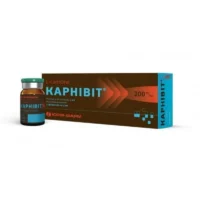Description
Ferrum Lek Solution for Injections 100 mg/2 ml Ampoules 2 ml №5
Ingredients:
Each 2 ml ampoule contains 100 mg of iron in the form of iron (III) hydroxide sucrose complex.
Mechanism of Action:
Ferrum Lek solution for injections works by replenishing iron stores in the body, which is essential for the production of hemoglobin and red blood cells.
Pharmacological Properties:
The iron (III) hydroxide sucrose complex in Ferrum Lek solution is well-absorbed and utilized by the body to correct iron deficiency anemia effectively.
Indications for Use:
Ferrum Lek solution for injections is indicated for the treatment of iron deficiency anemia in adult patients when oral iron therapy is inadequate or not feasible.
Contraindications:
Do not administer Ferrum Lek solution for injections to patients with hypersensitivity to any component of the product, hemochromatosis, or anemia unrelated to iron deficiency.
Side Effects:
Common side effects may include gastrointestinal disturbances, allergic reactions, and injection site reactions. Severe hypersensitivity reactions are rare but possible.
Usage Instructions:
The recommended dosage of Ferrum Lek solution should be individualized based on the patient’s iron status and should be administered intravenously by healthcare professionals following appropriate dilution and infusion guidelines.
Benefits Compared to Analogues:
Ferrum Lek solution offers a rapid and effective way to address iron deficiency anemia, especially when oral iron supplements are not well-tolerated or ineffective. Its intravenous administration ensures direct delivery of iron to the bloodstream, bypassing potential absorption issues.
Suitable Patient Groups:
Ferrum Lek solution is suitable for adult patients with diagnosed iron deficiency anemia. It may be particularly beneficial for individuals with chronic conditions, malabsorption problems, or those who cannot tolerate oral iron therapy.
Storage Conditions and Shelf Life:
Store Ferrum Lek solution at the recommended temperature, away from light and moisture. Check the expiration date on the packaging and do not use the product beyond that date.
Packaging Description:
Ferrum Lek solution is available in ampoules containing 2 ml of the solution, with each ampoule providing 100 mg of iron in the iron (III) hydroxide sucrose complex formulation.
Clinical Evidence and Proven Effectiveness:
Clinical studies have demonstrated the efficacy of Ferrum Lek solution in correcting iron deficiency anemia. Auerbach et al. (2019) reported significant improvements in hemoglobin levels and quality of life in patients treated with intravenous iron formulations, including the iron (III) hydroxide sucrose complex.





